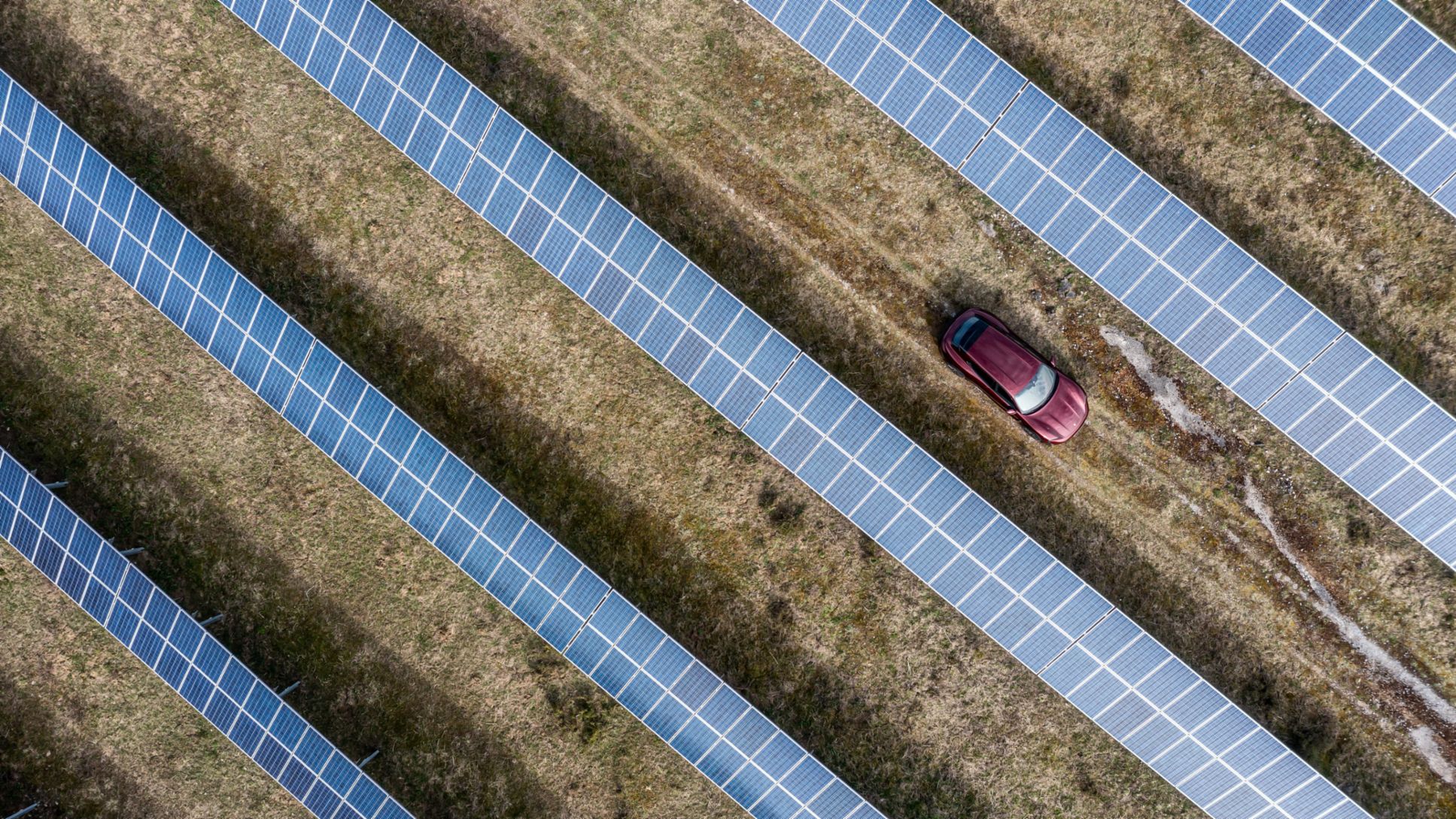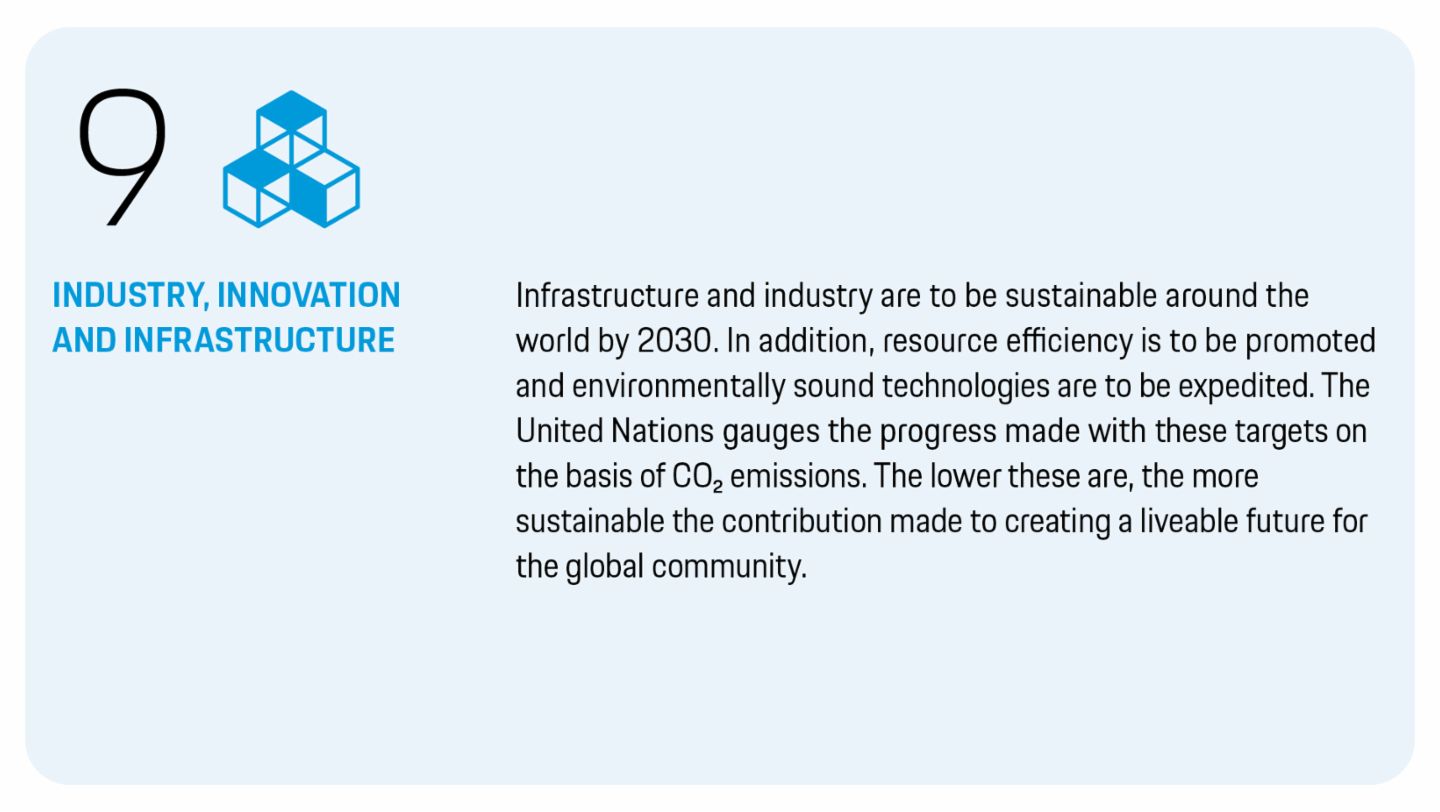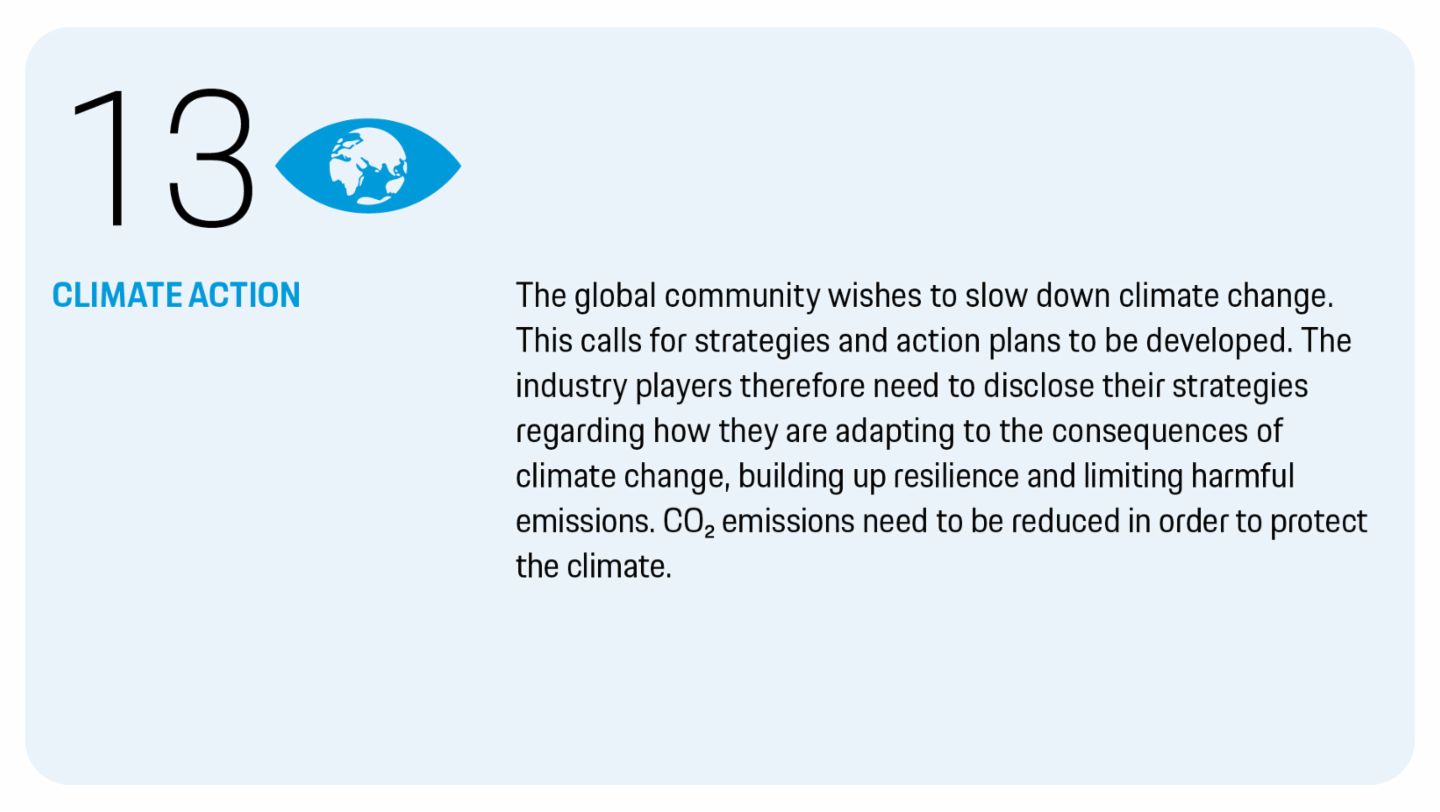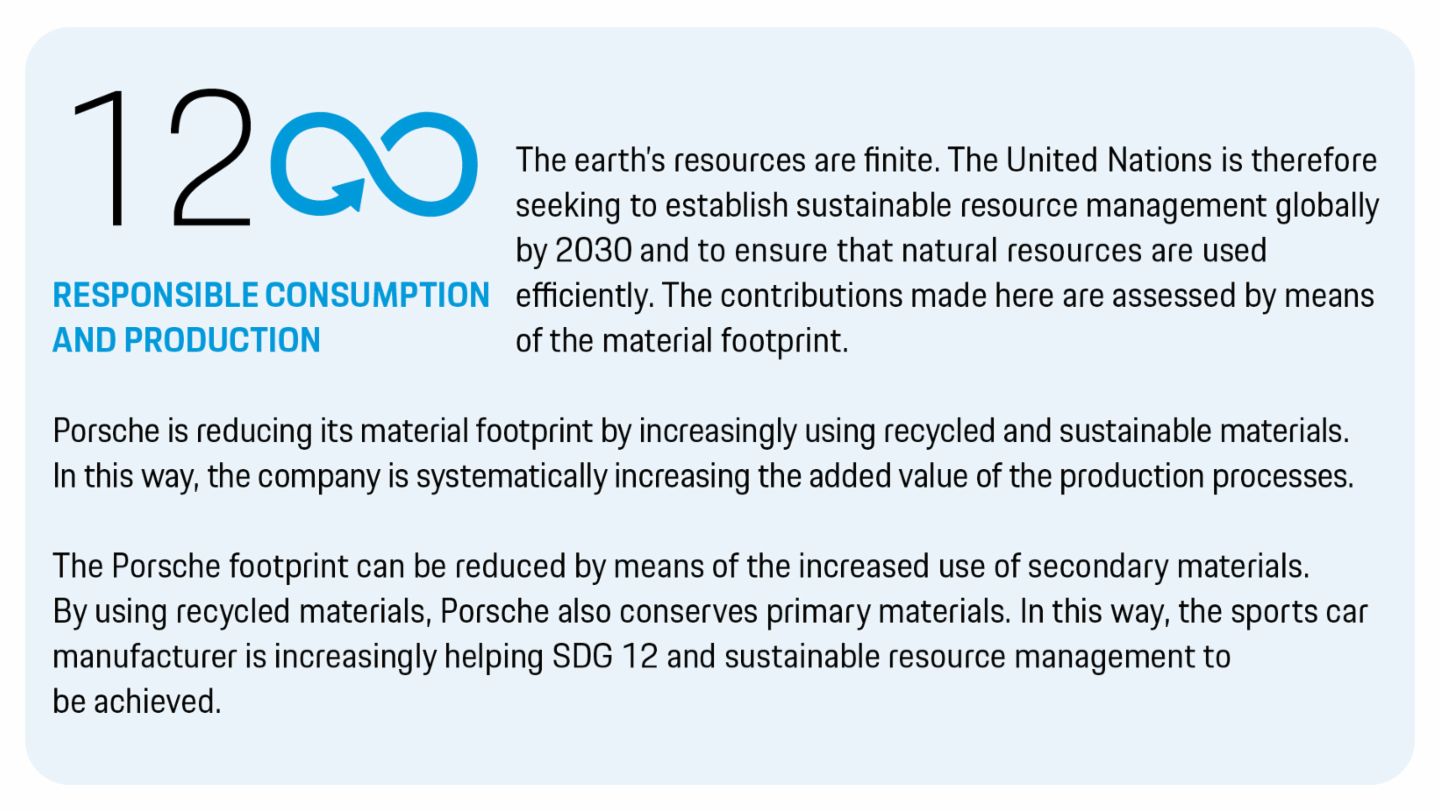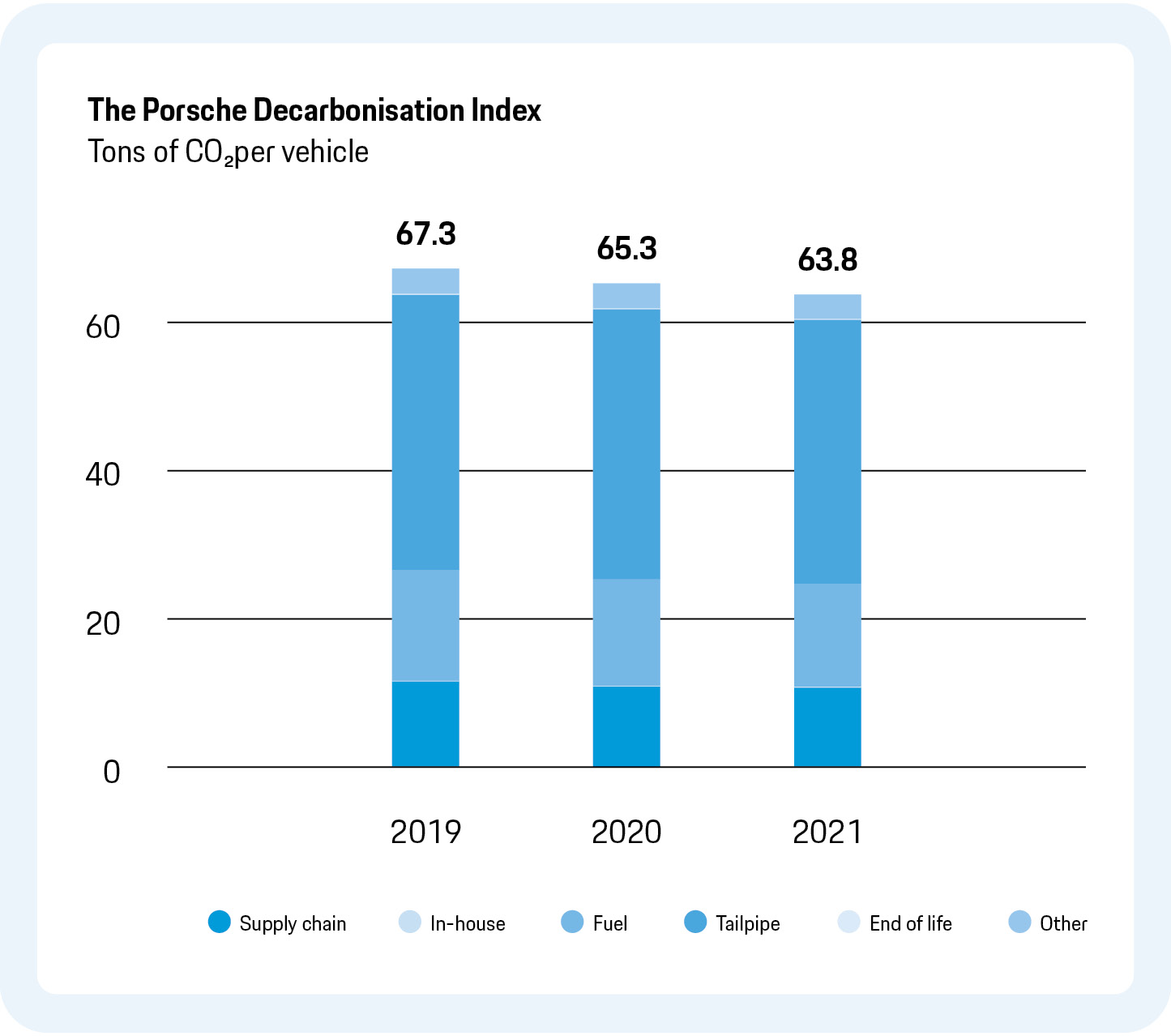Porsche has made a commitment to the climate targets agreed on in Paris in 2015. The company assumes responsibility for reducing environmentally harmful emissions. The product portfolio represents the core of its activities. Porsche is seeking to shape the mobility of the future with innovative products and technologies and attractive services.
Porsche has made a commitment to the climate targets agreed on in Paris in 2015. The company assumes responsibility for reducing environmentally harmful emissions. The product portfolio represents the core of its activities – Porsche is seeking to shape the mobility of the future with innovative products and technologies and attractive services. The premium manufacturer is developing future-oriented drive concepts in order to significantly reduce CO₂ emissions, focusing in particular on electromobility. Half of all new Porsche models are to have an electric motor, in other words be all-electric or partially electric, by 2025. Porsche entered this era back in 2019 with the Taycan, a thrilling sports car that blends tradition and the future. In addition to its electrification strategy, Porsche has enshrined the continuous decarbonisation of its products and business processes in its strategy. This applies to the entire life cycle. In addition to the CO₂ emissions caused by vehicle production, the emissions in the supply chain and during a vehicle’s service life are likewise taken into account.
Porsche calculates the volume of its CO₂ emissions in tons per vehicle all along the value chain using the Decarbonisation Index (DKI).1 This has fallen by around five per cent since the defined base year, 2019 (see Vehicle decarbonisation). As such, Porsche is contributing to sustainable industrialisation and is playing its part in SDG 9 and 13 being achieved.
1 Porsche bases its calculation of the DKI among other things on assumptions which are founded on statistics. They are model-based calculations that draw on company-specific premises and values and on data from LCA databases. Total vehicle mileage of 200,000 km is assumed for the Porsche fleet vehicles. Vehicle servicing is not factored into the calculation. Intrinsic tolerances cannot be ruled out of the modelling. The target of balance-sheet CO₂ neutrality in 2030 is founded on averaging.
Vehicle Decarbonisation (decarbonisation programme)
Porsche has initiated an extensive decarbonisation programme. Porsche wishes to achieve balance-sheet CO₂ neutrality across the entire value chain by 2030.
Advancing climate change means the global automotive industry has obligations. Newly developed vehicles and drive systems need to significantly reduce CO₂ pollution. Porsche intends to continuously lower its CO₂ emissions all along the value chain, including after its vehicles’ life cycles. The sports car manufacturer is intensively expediting the electrification and hybridisation of its product portfolio to this end. The vehicles are at the heart of an extensive and comprehensive decarbonisation programme within the sports car manufacturer’s strategy.
Target: decarbonisation and CO₂ neutrality
The company has initiated an extensive decarbonisation programme. Porsche wishes to achieve balance-sheet CO₂ neutrality across the entire value chain by 2030. This is the sports car manufacturer’s contribution to the UN’s climate targets being achieved.
Concrete measures have already been and will be adopted within the decarbonisation programme. These will be founded on three guiding principles, which also represent the priorities in descending order. At the top of the list are measures to avoid or reduce CO₂ emissions. Second come measures that seek to switch the energy sources used in the value chain to less CO₂-intensive or to renewable energies. And in accordance with the third guiding principle, CO₂ emissions which cannot be avoided will be offset through climate protection projects which meet the most stringent international standards.
Decarbonisation Index
The Decarbonisation Index (DKI) is Porsche’s most meaningful instrument for measuring and controlling progress across all the divisions. The aim of the DKI is to offer as comprehensive an overview as possible of the CO₂ equivalent emissions throughout the value chain. It is primarily based on life cycle assessments which Porsche performs on the basis of systematic methods that are standardised in ISO 14040/44.1 A life cycle assessment examines environmental impacts such as the CO₂ footprint caused throughout a vehicle’s life cycle during manufacture, use and recycling. The scope of consideration of a vehicle’s life cycle encompasses the vehicle and all of its parts:
- The supply chain and production include the emissions generated during raw material extraction, component production and the manufacturing steps of body construction, paintwork and assembly.
- Service life encompasses the emissions related to fuel/power supply as well as to vehicle operation over total mileage of 200,000 km per vehicle.
- Recycling assesses the emissions caused during disassembly
The DKI also records other emissions within the value chain including the energy and fuel emissions of non-production sites and business trip and logistics emissions.
1 Calculation is based on company-specific premises and values and on data from LCA databases. Vehicle servicing is not factored into the calculation.
The DKI therefore comprises the production sites’ direct and indirect CO₂e emissions (Scopes 1 and 2) on the one hand and also includes other upstream and downstream CO₂e emissions during a vehicle’s life cycle, in other words from raw material extraction and use through to the recycling of end-of-life vehicles (Scope 3).
The DKI is subject to regular modification due to changes in the internal and external requirements (such as test cycles) and advancements in findings. DKI values previously published can therefore be adapted to new premises and be changed for the purposes of presenting a methodologically consistent time series.
As a strategic performance indicator, the DKI contributes to the comprehensive management of the company’s progress in becoming CO₂-neutral. All the activities relevant to the DKI are consolidated within the Decarbonisation Task Force and are assessed by a group of experts from various business divisions. The body draws up proposals of targets and tracks the progress made in each case. It also manages the defined strategic programmes on the basis of performance indicators and adopted ramp-up curves. It serves as a forum for the discussion of content and lays the groundwork for policy decisions in the relevant management and steering committees. The Porsche management bodies report the DKI all the way up to the Executive Board. They also adopt binding targets for the various business divisions. For example, the product development process features target values at the vehicle level.
Vehicle fleet electrification is a key lever for reduction of the Decarbonisation Index (DKI). Other leverage points include making systematic use of green electricity, definition of the DKI targets for vehicle projects and the decarbonisation of production.
All the Volkswagen Group brands calculate the Decarbonisation Index on the basis of standardised methodology. It is then consolidated as a performance indicator at the Volkswagen Group level.
Vehicle fleet electrification is a key lever for DKI reduction. Other leverage points include making systematic use of green electricity, definition of the DKI targets for vehicle projects and the decarbonisation of production.
Porsche’s DKI has fallen by around five per cent since the defined base year, 2019. The two levers with the biggest influence on reduction are the electromobility campaign and the renewable energy strategy for the service lives of vehicles.
Production Decarbonisation
CO₂ emissions per vehicle reduced by more than 90 per cent at the company’s own production plants.
Porsche is clearly committed to the goals of the Paris Agreement. The sports car manufacturer is to be balance-sheet CO₂-neutral across the entire value chain from 2030. Porsche is systematically pursuing an electrification strategy and is setting itself ambitious decarbonisation targets, also in comparison with the rest of the industry. The CO₂ emissions of the company and its products are to be reduced throughout the life cycle. The sports car manufacturer’s own production activities constitute a key part of its decarbonisation programme. Porsche has therefore additionally developed a target vision of a zero-impact factory for its production activities, comprising 11 areas of action. The consumption of materials and resources is another focal area. The aim is to achieve closed cycles wherever possible.
Target: balance-sheet CO₂ neutrality
At Porsche, environmental protection is determined on the basis of internal policies and strategic guidelines. The Group’s Environment and Energy Management guideline defines a standardised approach and the responsibilities. It assists the Group companies in systematically identifying, fulfilling and reviewing all the environmental and energy requirements.
Porsche is working towards the clear goal of a zero-impact factory that produces without any negative environmental impacts. The factory for the all-electric Porsche Taycan at the main plant in Stuttgart-Zuffenhausen is the first milestone in this direction. When expanding the plant, the company additionally optimised the entire site and made it balance-sheet CO₂-neutral. The minimal remaining CO₂ emissions are offset.
The sports car manufacturer has reduced the CO₂ emissions per vehicle at its own production facilities by more than 90 per cent since 2014. The energy supplies at the two production sites in Stuttgart-Zuffenhausen and Leipzig are sourced from green electricity and biomethane.
The environmental pollution caused by production is to be reduced by 45 per cent between 2014 and 2025.
The Member of the Executive Board responsible for Production and Logistics is responsible for systematic implementation of the necessary measures and is assisted by the Environment and Energy Management department. The projects include reducing the environmental impact of production by 45 per cent between 2014 and 2025. This target figure includes energy and CO₂ per vehicle.
Certified management systems
The Porsche strategy defines short-, medium- and long-term environmental and energy management measures. These are founded on the environment and energy efficiency strategy and environmental policy. Top management evaluates these set targets and measures at least once a year and accordingly determines what action is required. The overarching intention is to achieve ongoing improvements, in particular implementing the requirements as per ISO 14001, ISO 50001 and the EMAS Regulation.
All the requirements are presented in Porsche’s environmental compliance management system (ECMS). A guideline stipulates a standardised approach for the company and its subsidiaries. The ECMS is part of the company’s overall management system. It serves to organise and determine the responsibilities and procedures regarding environmental and energy aspects within all the departments and divisions. The ECMS requirements are based on the specifications of the Volkswagen Group and are incorporated into the Porsche specifications by the Environment and Energy Management department. This ensures that binding obligations are met. At the same time, the environmental aspects of sustainability are to be taken into account in all business processes. The Stuttgart-Zuffenhausen plant has enjoyed validation under the Eco-Management and Audit Scheme (EMAS) for over 20 years. It has also been in compliance with the ISO 50001 energy management standard since 2011.
In addition to the Stuttgart-Zuffenhausen plant, Porsche Leipzig GmbH, the Weissach Research and Development Centre and its external sites, the central parts warehouse in Sachsenheim and Porsche Werkzeugbau GmbH have all likewise been certified as compliant with this standard and with the ISO 14001 environmental management system. Porsche records the environmental impacts at the Stuttgart-Zuffenhausen site, assessing all the relevant environmental pollution in the air and water, energy consumption and waste volumes.
Independent third parties audit the official certifications. In addition, Porsche performs annual system and process audits to determine whether and to what extent all the applicable environmental and energy legislation is being observed and adhered to across the company.
Efficient use of energy
Porsche is continuously promoting and increasing the proportion of the renewable energies that the sites generate themselves. In Leipzig, for example, the company makes use of the solar energy generated by a four-megawatt photovoltaic system. Highly efficient combined heat and power plants with overall efficiency of more than 83 per cent cover most of the remaining energy needs.
New buildings go far beyond the minimum statutory energy efficiency requirements. One plant has already been certified in accordance with the highest standard stipulated by the German Sustainable Building Council (DGNB). In addition, minimum criteria have been stipulated for new builds.
Environmental compliance
Environmental protection is one of the six compliance topics at Porsche. Europe-wide regulations and directives, German national laws, federal state laws and ordinances, and municipal by-laws must be observed. The Environment and Energy Management department ensures compliance through officers who follow and assess all the legal developments and then notify the company divisions affected. We are not aware of any violations of environmental or energy legislation regulations at Porsche sites in the reporting period.
Alternative Drive Systems
The Porsche drive strategy is based on a technology triumvirate: emotive combustion, powerful hybrids and high-performance e-mobility. As such, Porsche reflects the demands and needs of the customers, the environment and the policymakers. This triumvirate is complemented by the use of new technologies available in the market such as eFuels.
Drive strategy based on three pillars
The company will simultaneously offer vehicles with optimised petrol engines, powerful hybrid drives and all-electric sports cars. The plug-in hybrids in the Panamera and Cayenne model lines will continue to be designed with high performance in mind, with greater electric ranges of more than 80 kilometres. Going forward, very sporty hybridisation will be possible in the case of the iconic 911 sports car too. This has already been seen in motorsport.
Porsche has earmarked around 15 billion euros in the electrification, digitalisation and sustainable production of its vehicles up to 2025. The company is therefore systematically expanding its range of electromobility offerings. Fifty per cent of all newly sold cars are to be electrified by 2025, i.e. be all-electric or plug-in hybrids. An electric vehicle causes fewer CO₂ emissions than a comparable vehicle with an internal combustion engine. As renewable energies can be used during an electric vehicle’s service life, one of the biggest levers for reducing the CO₂ footprint can be found in this area. Porsche is accordingly looking to use sustainable energy sources such as wind and solar power.
Based on the advantages of e-mobility, Porsche has decided to adopt a systematic electrification strategy. With this path it has chosen, the company is seeking to establish itself as a technology leader. To make the breakthrough, e-mobility needs an accessible, available charging infrastructure that meets demand and provides a customer-friendly charging process. Porsche is pursuing a holistic approach and continues to work on refining charging technologies and developing the charging infrastructure. The aim is for new products and services to turn charging into a personal customer experience that is fast and attractive.
A network of 350 kW quick-charging stations is being expanded and expedited throughout Europe with the joint venture IONITY. The plan is to have 400 charging stations up and running. At home, Porsche customers can top up the Taycan’s battery overnight using a Porsche-developed wall box providing up to 22 kilowatts. And on the road, the Porsche Charging Service already provides users with access to more than 100,000 charging points throughout Europe with the possibility of central billing.
Alternative fuels
Porsche is prioritising its electrification strategy. The company is additionally pursuing avenues to reduce the CO₂ emissions of vehicles with petrol engines and hybrid drives in certain areas by means of efficiency measures. Here, Porsche is focusing on what are known as eFuels. Porsche classifies eFuels as synthetic, liquid fuels. These are made of hydrogen obtained exclusively using renewable energy and non-fossil carbon dioxide extracted from, for example, the ambient air.
With eFuels, the traditional Porsche models could potentially be run virtually CO₂-neutrally too. Together with partners in science and industry, the company is working to develop industrial production of these alternative fuels. Porsche is seeking to develop the best locations around the world for the use of renewable energy sources in order to guarantee that these new energy carriers will be competitive. To further improve the production processes, Porsche is involved in, for example, the “eFuels – Kraftstoffe neu denken” project in Baden-Württemberg, which was established as part of the Baden-Württemberg Strategiedialog Automobilwirtschaft initiated by the Baden-Württemberg state government.
In collaboration with Siemens Energy and a number of international businesses, Porsche developed a pilot project in Chile during the reporting year. The aim of the project is to develop the world’s first integrated, commercial, large-scale plant to manufacture synthetic, climate-neutral fuels. The plant is being constructed according to the principles of environmental and social compatibility. The pilot phase will involve the production of some 130,000 litres of eFuels in 2022. The capacity is then to be increased in two stages to around 55 million litres in 2024. By 2026, an additional 550 million litres a year are planned. Porsche is the main buyer of the green fuel manufactured by the pilot plant using electric power generated by the wind. The project site in Chile boasts very good parameters in comparison to elsewhere in the world, with consistent and strong winds. This results in very low power generation costs and therefore also low production costs. Furthermore, additional renewable energy is generated which does not compete with other industrial needs.
Diesel
As of February 2018, Porsche no longer includes any diesel models in its portfolio. Together with other parts of the Group, the company is also actively committed to bringing down nitrogen oxide levels in German cities. Before Porsche’s decision to stop selling diesel-powered vehicles, Germany’s Federal Motor Transport Authority, the Kraftfahrtbundesamt (KBA), had ordered a recall measure to update the software in certain Porsche diesel vehicles owing to irregularities in the engine management software. The relevant recall for all affected Porsche diesel cars was launched. In 2017, Porsche Cayenne 3.0-litre V6 diesel cars in the Euro 6 emissions class were recalled in Germany due to individual technical characteristics of the engine management software. In mid-October 2017, the KBA approved the software update proposed by Porsche. Porsche has since recalled the vehicles concerned for a free software update. More than 99 per cent of the affected vehicles in Germany have now been updated.
In July 2018, the KBA ordered cars of the type Macan 3.0-litre V6 diesel (Euro 6) to undergo a similar update. The proposed Porsche software update received official approval on 1 August 2018. Porsche has been recalling these vehicles to workshops for a free software update since October 2018. Currently more than 99 per cent of the vehicles registered in Germany have been updated.
In addition, the KBA issued Porsche with recall notices for the Cayenne 4.2-litre V8 diesel (Euro 5 and Euro 6) and Panamera 4.0-litre V8 diesel (Euro 6). Porsche’s proposed software update for the Panamera 4.0-litre V8 diesel (Euro 6) was approved by the KBA in August 2019. The recall campaign started in November 2019 and the software update has already been applied to around 98 per cent of the affected vehicles. Approval was granted by the KBA for software updates in respect of the Cayenne 4.2-litre V8 diesel (Euro 5 and Euro 6) in January 2020 (Euro 5) and July 2020 (Euro 6). The owners of the vehicles have been contacted by the responsible Porsche partners and the recall campaign has been launched. So far, some 88 per cent of the Cayenne 4.2-litre V8 diesel (Euro 5) and Cayenne 4.2-litre V8 diesel (Euro 6) models in Germany have been updated.
In addition, Porsche voluntarily announced that it would produce software updates for Euro 5 3.0-litre V6 diesel Cayenne and Panamera models. The KBA approved this software update in January 2020. The service campaign was published immediately in the market and made available to customers as a free software update. Currently around 62 per cent of the vehicles registered in Germany have been updated. The software update will also be made available in other EU countries shortly.
New Mobility Concepts
Porsche is working on services that will make urban mobility more flexible and more convenient.
Scarcity of resources and climate change are intensifying innovation and market dynamics. Vehicles and their usage are adapted to these. On the one hand, the result is greater diversification of drive concepts in the direction of more efficient versions. And on the other, innovative, flexible vehicle usage models are being developed. Meanwhile, the customers’ mobility needs are changing rapidly too in terms of both car ownership and car use. Digitalisation, connectivity and the customers’ desire for greater flexibility and sustainability are accelerating this change. The customers expect mobility offerings ranging from hardware concepts to digital services that enable movement.
Personal mobility in the smart city
Mobility today means so much more than simply moving from A to B. Owning a car in an urban environment is raising more and more questions. Porsche is therefore also working on services that will make urban mobility more flexible and more convenient. In cities, mobility is gaining importance as one of the most relevant areas in which quality of life can be improved, making urban planners important stakeholders in the automotive industry.
Measures that answer existing questions, including regarding congestion, CO₂ and noise emissions, lost time and parking space scarcity, are being prioritised accordingly. Close collaboration between city councils and the providers of new mobility solutions is therefore key.
Porsche is developing innovative products and services as an expression of flexible mobility which is in keeping with the needs of the times. The aim is to make personal mobility sustainable and to make smart cities a reality. It is a question among other things of demand-oriented car usage options (for example, flexible usage models and premium rental) and seamless connection to other forms of transport.
Electrification of the Porsche fleet therefore also has an important part to play in the development of mobility products. All the services offered under the Porsche Drive umbrella brand are a response to changes in the customers’ wishes. They reconcile flexible, digital and personalised use with electric vehicles. Flexible solutions such as Porsche Drive Flex, Porsche Drive Subscription and Porsche Drive Rental are designed to make it even easier for the customers to get into electromobility. They allow customers to experience electric driving for an extended period without having to immediately commit to something. Porsche is therefore closely linking electromobility and mobility. In the Porsche Drive Flex pilot project, customers can choose from among various vehicles within their subscription and define their choice of vehicle via the app. The Taycan is also available under Porsche Drive Subscription, which closes the gap between short-term rental (up to 28 days) and traditional leasing (from 12 months). The Taycan model series was offered with special conditions to generate added incentive.
Targeted collaboration
To keep pace with the changing requirements, responsibility for mobility services was pooled under the auspices of Porsche Financial Services. The mobility offerings are developed and scaled globally in close collaboration with Porsche AG, the importers, the subsidiaries of Porsche Financial Services and other internal and external partners. The products offered are to be as efficient as possible so as to afford the customers a premium user experience. The development of digital solutions in close cooperation with Porsche Digital GmbH is therefore a top priority.
Agile, interdisciplinary teams develop concepts that are focused primarily on new customer requirements and implement these in a targeted manner. Success is guaranteed on the basis of the intensive collaboration of the company’s different departments, an open information policy, early piloting in various markets and prompt stakeholder involvement. Synergies within the Group are systematically exploited in the development and implementation of services.
Porsche uses a number of tools for fine adjustment to continuously optimise the existing and new mobility services. These include offsetting the local CO₂ emissions of the Porsche Drive fleet with the Porsche Impact offsetting service and making increasing use of digital processes.
Managing mobility at the sites
Another priority is the expansion of a sustainable range of mobility options for the employees at Porsche sites. The aim of company mobility management is to make the employees’ commutes and business travel more sustainable. The company has been systematically realising various measures for this since 2015. For example, employees receive a monthly subsidy for a local transport season ticket targeting commuters as well as for a Deutsche Bahn Jobticket. In addition, travellers on the S-Bahn light rail link between the company’s Weilimdorf and Zuffenhausen sites in Stuttgart can present their Porsche works ID card in lieu of a travel ticket when on company business. Frequent shuttle buses run back and forth between the sites for all other work trips in order to reduce the amount of individual traffic. Porsche also introduced a company cycling scheme back in 2019, offering the employees attractive subsidised bike purchase options.
Porsche is making its fleet of company and leased cars electric and is expanding the internal charging infrastructure.
To make the transport options even more flexible, a digital, static parking guidance and information system was installed in the year under review and a company-wide mobility dashboard was established. Here, the employees are notified of available parking spaces and traffic volumes in real time. The company makes local public transport services and Porsche shuttle services available at the sites. Porsche is also implementing a pilot project at its Stuttgart-Zuffenhausen site. Business divisions with greater mobility needs will be able to use e-bikes for business purposes in the future.
Due to how the pandemic has developed, other measures to expand mobility services are in the pipeline. In addition to a carsharing/commuting app being reintroduced, these include the expansion of bike services such as the development of bike service points.
As part of the expansion of sustainability and alternative forms of mobility, Porsche is promoting the electrification of its motorised site traffic. The internal charging infrastructure is being extended and powered by certified green electricity and new electric vehicles are being added to the fleet of company and leased vehicles all the time. In addition to the infrastructure, other management measures and complementary services were realised in the year under review.
The impact of the projects on the targets set is gauged on the basis of employee surveys and traffic flow analyses. These show that the total volume of traffic continues to improve. There has also been a positive change in the modal split, i.e. the distribution of traffic across a range of transport options.
